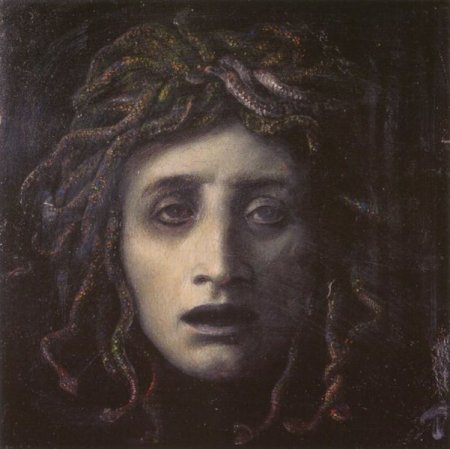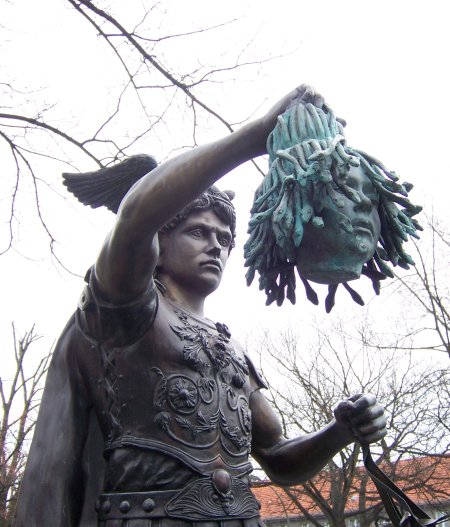me d usa med usa

Arnold Böcklin “Medusa” – image source from wikipedia
MEDUSALEM. Researchers from Israel found out that our Internet galaxy has in its center a Medusa head (they call it actually a Medusa model), i.e. a head which grows snakes instead of hair.
This is of course only a metaphor. But honestly – the internet is wired in an astonishing way. The researchers assert (here the paper by Carmi et al via pop sci) that the nodes of the Internet can roughly be divided into 3 major categories.
(In this context nonmathematicians may want to read about the bridges of Königsberg which belongs to the mathematical field of topology see also an old randform post about trees (a special graph)).
The authors first take away nodes with one edge (=connection to a neighbour) and call the resulting graph a 1-shell, they construct a 2-shell by taking away nodes with two edges and less which results in a graph called 2-shell and so on until they finally reach after kmax steps a shell called the kmax-shell which is given by the fact that the kmax+1 step would result in an empty shell.
The three major categories of internet nodes are:
1. those nodes which belong to the kmax shell, they form what the researcher called the nucleus or the “head of the medusa” (these are about 100 nodes).
The rest of the nodes can be divided into
2. a large connected component (~70-80% of the internet, about 15000 nodes) and
3. the “hair of the medusa”, i.e. a collection of nodes (~20-30% of the internet, about 5000 nodes), which is not connected with the large connected component but just with the nucleus. In particular – if you cut off the head of the medusa (the nucleus) then the hair goes with it, i.e. these nodes are cut off from the internet if the nucleus is removed (and may be these nodes should think of alternative means of communication), whereas the large connected component would still be working.
But in fact overstraining the metaphor of the Medusa who was “a monstrous chthonic female character, essentially an extension of an apotropaic mask, gazing upon whom could turn onlookers to stone” (wikipedia) may suggest to indeed cut off the nucleus (i.e. her head) because in this case 70% of the internet may be a bit slower (see tech review link below) but these 70% are then not anymore in danger of turning into stone. (just joking).
Another interesting question which was tackled by the authors was “Does the size of the nucleus increase with the Internet size and how?”. They couldn’t (yet) seperate the actual growth of the internet from the increase in their measurement sensitivity thus they were led to investigate random ensembles of scale free networks similar to the real internet. Their result suggests that the nucleus as well as the maximal degree “grows as a power of N” (size of all internet nodes (?)). So may be it explodes some day by itself. metaphorical problem resolved (again just joking).
However this post was meant to be serious. So let’s carry on seriously. Among others the authors used methods from percolation theory to investigate the large 70%-connected component and in particular focused on the percolation threshold of k-crusts (unions of (j<=k)-shells) with k close to 6, where the connected part is expected to display fractal properties, which is apparently in accordance with percolation in homogenous random networks. There seems to be an interesting new text book on the market called: Networks – Optimisation and Evolution by Peter Whittle, from the Cambridge Series in Statistical and Probabilistic Mathematics. However it is expensive (I think too expensive for me).
The investigation used data which were among the results of DIMES which is part of the EVERGROW european integrated project of the 6th framework’ s Future and Emerging Technologies division. DIMES collects 3-6 million measurements daily from a global network of more than 10000 software clients. The measurement tool is a software client which was sofar downloaded by at least 5000 volunteers (according to the article).
It would be nice to see the data linked to geography. But maybe this is confidential data. This reminds me of a real estate ad, which once offered a beautiful baroque-style (if I remember correctly) house in the center of Hannover. The offer contained the information that the basement of the house hosted a major node of the federal state of Niedersachsen which should be left untouched and accessible. I have no idea who finally bought the house – however I could imagine who would be interested in such a deal.
Whatsoever.
Funnily I found the info on the article first on pop sci and then one day later on
tech review.
Concluding one should maybe note at this place that the life of a Medusa’s head in Berlin is rather prosaic. Below you can see (the head had already been cut off by Perseus) how it is parking in front of a building which I think belongs to the former Kaiser Wilhelm Institute in Berlin-Dahlem.

October 3rd, 2011 at 8:58 am
Very funny images. That sculpture looks quite dramatic. By the way what is the role of Medusa’s snake hair?
October 4th, 2011 at 6:09 pm
d’Artagnan?????!!!!
Ey Alter, dit gloobste nich – jetze kommn hia schon Muskeltiere anjaloppiert!
October 5th, 2011 at 12:33 pm
Na ja Muskeltier, ick wees ja nich
October 6th, 2011 at 11:32 am
d’Artagnan wrote:
I was asking this also myself. The theory in the german Wikipedia is that Athene was very angry about Medusa (who was originally an enchanting beauty), because she unexpectedly found Medusa in a hanky-panky with Poseidon and thus transformed her into an ugly beast by giving her snake hair, large canines, scale armor, fervent eyes and a hanging tongue. She was then so ugly that her sight made everybody turn into stone.
I could imagine that the snake hair somewhat may symbolize evil thoughts which emerge from Medusa’s head….likewise as certain aureolae could want to suggest that they are a kind of “hair” which symbolizes good, bright and beaming thoughts…on the other hand this guess may be a bit limping since aureolae are sometimes rather hard-disk-like-round shaped.
October 10th, 2011 at 10:23 am
nad wrote:
Interesting, this post had sofar slipped my attention. Do you know which house it was? But whatsoever – I can imagine that the german authorities checked the potential buyers.
October 11th, 2011 at 1:52 pm
Markao te King wrote:
I don’t recall the exact location of the house, but I guess the authorities would. The ad was posted around 1997. Of course I hope that the german authorities checked the potential buyers last but not least the german authorities are there to care for their people. Unfortunately there sometimes seems to have been not always adequate care. Like there is currently quite a discussion about a possible breach of laws and a major security flaw of some particular software used by german authorities. In particular the people atCCC who detected the flaws write:
.
The story is quite making the headlines over here in Germany, international mass media seems not so interested in the case, however The Red Tape, MSNBC has some english coverage on that case.
November 9th, 2011 at 10:22 am
wenn ick ma die bildchen da so ankieke — jibt dit eijentlich och münzheilje? So vielleich bei die altn röma?